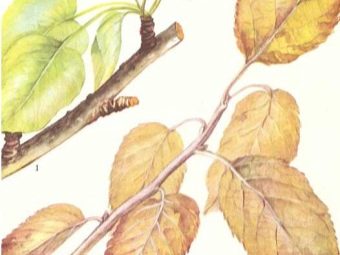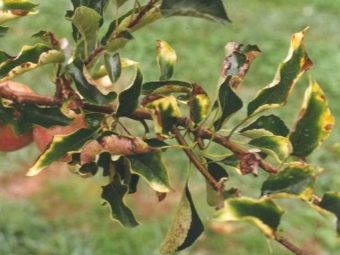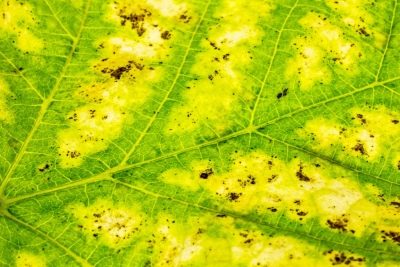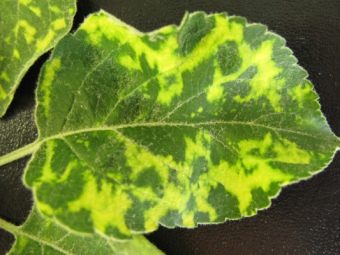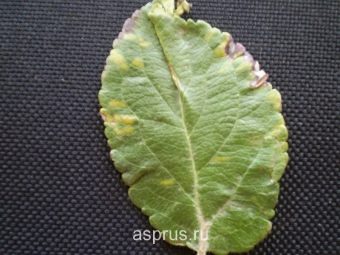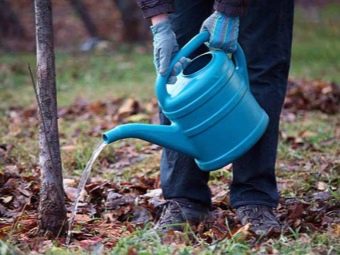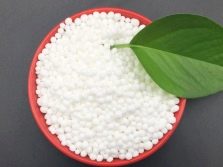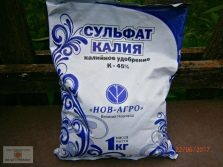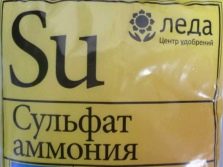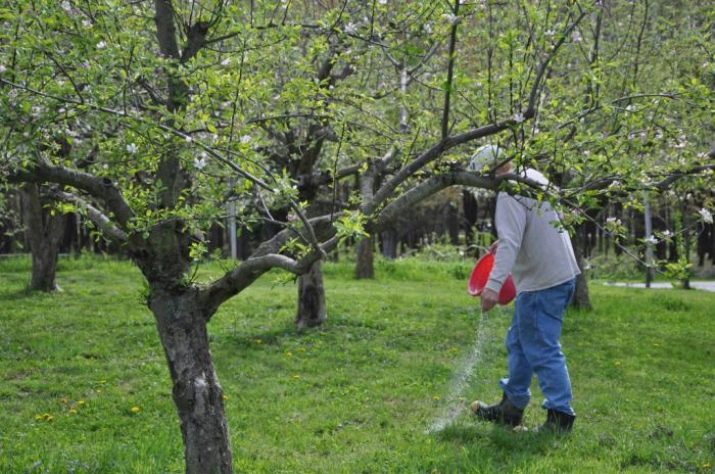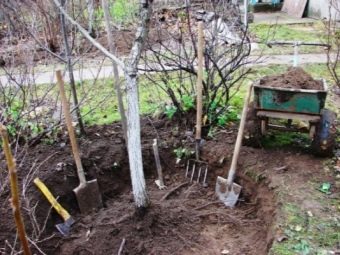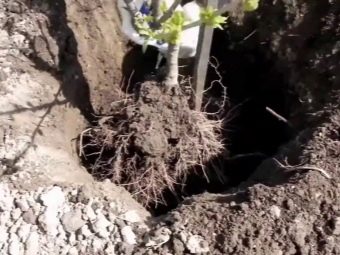Chlorosis of the apple tree: why does the disease appear and how to get rid of it?

Apple tree pleases with tasty and juicy fruits, however culture lurks a lot of dangerous diseases. Chlorosis is one of them.How to cope with this trouble, this article will tell.
Causes of
Chlorosis of the apple tree, like many other diseases, occurs against the background of a lack of trace elements and an insolation deficit. If you do not eliminate the disease in a timely manner, it can last a whole season. In this case, inevitably a violation of normal metabolism and yield reduction Ailment can be caused by a deficiency of various nutrients. The viral nature of apple chlorosis is almost eliminated.
Varieties and signs of the disease
To notice that the apple tree is sick with chlorosis is not difficult.
When such a disease occurs:
- the foliage first turns pale and then begins to turn yellow;
- leaves are covered with dissimilar dots of dark flowers;
- the perimeter and the tips of the leaves die off;
- at the same time the veins retain a green color.
Different forms of chlorosis give a different “clinical picture”. So, if the apple tree lacks iron, or it is poorly absorbed, the leaves begin to turn yellow in the upper part of the shoots, only then the lesion spreads down. The weak digestibility of iron is largely due to the growing of trees on carbonate soils. But the appearance of faded leaves at the bottom suggests that plants suffer from nitrogen deficiency. If young apple trees are faced with a lack of potassium, the foliage in the middle of the shoots becomes colorless.
The yellowing areas in the gaps between the veins and the appearance of dark inclusions surrounded by dying out areas indicate a shortage of manganese, as well as magnesium. A similar condition has received a special name - spotted chlorosis. It is provoked by excessive amounts of lime in the ground. In apple-affected trees with spotted chlorosis, leaf clarification first occurs near the base of the shoots. Another sign pointing to this particular disease is a reduction in yield.
A yellowed crown often expresses an unmet need for oxygen and sulfur. The risk is increased if you plant an apple tree on heavy ground, where the air permeability of the root zone is low. Another likely cause is excessively high levels of soil water. Exact determination of the type of pathology is possible only at its earliest phases. Later, the lesion covers all or almost all foliage; therefore, some varieties of chlorosis may be masking some forms.
It is important to consider that other diseases of the apple tree may be similar to chlorosis. If it is affected by mosaic, the color changes unevenly - spots and even stripes are clearly visible. Gradually, they turn pale yellow from a rich yellow and then die. Sick foliage falls prematurely to the ground. According to how precise the pattern is, professional agronomists can even recognize the virus strain.
Unlike mosaic, chlorosis causes changes not only on the leaves, but also on the fruits, and on the shoots. It also excludes such a characteristic consequence of the mosaic virus, as deferred fruiting. Additionally, you should check whether the tree is affected by chlorotic ring spots. It is expressed in the appearance of pinpoint yellow spots on the leaf plates. Small specks are systematically transformed into rings, and the leaves are deformed.
When chlorotic ring spots occur, the overall growth of the apple tree slows down. Her shoots are too short, stops increasing the circumference of the trunk. Diseased plants are extremely ill survived cold periods. The need to carefully check the actual nature of the disease is due to the fact that viral disorders with a similar picture are extremely dangerous.
If in doubt, it is recommended to consult with professionals.
Treatment products
Elimination of forms of the disorder that are not associated with infections is relatively easy - all that is needed is to fill the deficit of the problematic trace element. Chlorosis can occur in any season. It is necessary to deal with it immediately, when the first symptoms appear.It is possible to use protective equipment both by spraying and by adding reagents to the area near the barrel. Selection of options is taking into account the characteristics of the disease.
The fight against iron deficiency often involves the use of special compounds - chelates. Along with their use in pure form, many farmers prefer to use branded products (Agricola and other similar preparations). Processing takes place 2 or 3 times with intervals of 10 to 12 days. Farmers with experience often refuse expensive factory mixes and use of vitriol. A typical recipe is this: 90 g of citric acid and 45 g of vitriol are diluted in 10 liters of water. Sometimes the components are replaced by a combination of 45 g of vitriol and 30 g of vitamin C. The prepared mixture can be watered 1 affected plant.
If iron starvation is very serious, injectable iron sulfate is injected. We'll have to drill small channels, pour the necessary composition into them and close the entrance with cement. There are also dry injections when iron sulfate tablets are used. But this is an emergency measure, and only improving the composition of the soil helps to drastically improve the situation. If iron is not absorbed, you need to seek to reduce the amount of carbonates in the soil.
You can prevent iron deficiency by improving the composition of the earth in advance. To do this, 1.5 kg of vitriol is mixed with 60 kg of humus, add 100 liters of water and used for watering the tree trunk circle. You can also dig several grooves 0.4 m deep in the same circle. On these grooves scatter 0.5 kg of iron sulphate, trying to distribute it evenly. An interesting fact is that in the past they tried to fight with iron chlorosis by buried metal objects near the apple trees.
The fight against nitrogen and potassium chlorosis is carried out at the expense of complex supplements, including both substances at the same time. Top dressing is carried out in the spring.
From improvised means useful (when diluted in 10 liters of water):
- 35 g of urea;
- 25 g of potassium sulfate;
- 40 g of ammonium sulfate;
- 40 g of ammonium nitrate or nitroammofoski;
- 50 g azofoski.
Chlorosis, associated with a deficiency of magnesium and manganese, is eliminated immediately by two supplements. Magnesium deficiency disappears if you put dolomite flour under the root and water the plants with magnesium nitrate in the form of a solution with a concentration of 0.1%. Additional support will be the use of magnesium sulfate, 150 g of which is diluted in 10 liters of water. The solution is used for spraying the leaves. Manganese is transferred to apple trees in the composition of wood ash, so-called manganese sludge can also be used. The foliage is sprayed with a 0.05% sulphate solution.
To compensate for the lack of oxygen, we need:
- systematic loosening of the wheel circle;
- adding organic matter;
- competent mulching.
Preventive measures
In order for the apple trees not to suffer from chlorosis, it is required to determine the composition of the soil from the very beginning and correct it with various additives. At the same time, it is worth striving not only to increase the presence of one or another component, but to achieve an optimal balance. Since the necessary substances are poorly absorbed by apple trees growing on carbonate earth, it is necessary to use gypsum. It also helps with the excessive presence of lime in the ground.
Gypsum is carried out at the very beginning of spring, when they dig up near-trunk circles. If the earth is acidic, then, on the contrary, chalking is required. Avoid planting trees in areas with poor drainage.
If such a mistake is made, the only way out is to transplant the apple tree. You should also deal with pests that carry pathogens of infectious forms of chlorosis.
For the treatment and prevention of chlorosis, see below.

